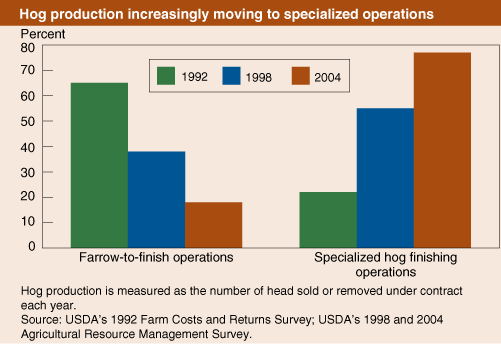Hog Operations Increasingly Large, More Specialized
- by William D. McBride and Nigel Key
- 2/1/2008
Structural change in U.S. hog production during the past two decades has had profound effects on industry performance and on strategies for dealing with change. Hog producers have increased productivity and reduced costs through major adjustments to the size, organizational structure, and technological base of their operations. These adjustments have lowered pork prices for food processors and consumers. However, concentrated hog production has imposed environmental risks and nuisance impacts on nearby communities. In addition, society in general has raised concerns about food safety and animal welfare issues.
As hog production has consolidated, fewer and larger operations account for an increasing share of total output. The number of hog operations fell by more than 50 percent during the past two decades, while the hog inventory remained relatively stable. From 1992 to 2004, average production from hog operations grew nearly fivefold to 4,646 head in 2004. Over the same period, the share of the total hog inventory held by operations with 2,000 or more head increased from less than 30 percent to nearly 80 percent; in 2004, operations with 5,000 or more head held 50 percent of inventory.
The traditional approach of farrow-to-finish hog production (all stages from breeding until slaughter) has given way to operations that specialize in a single production phase. Specialized hog finishing operations accounted for 40 percent of hog operations in 2004, up from 19 percent in 1992. Operations specializing in farrowing and raising weanlings, so low in number as to be rarely reported in 1992 and 1998, totaled 7 percent of operations in 2004 and produced an average of more than 20,000 head per farm. Overall, the share of hog production from farrow-to-finish operations fell from 65 to 18 percent during 1992-2004, while that from specialized hog finishing operations increased from 22 to 77 percent.
Contracting contributed to much of the growth in production from specialized hog operations. Production from hog operations using contracts grew from 5 percent of the total in 1992 to 67 percent in 2004. Production contracts between growers and hog owners, rarely used under the farrow-to-finish approach, have facilitated the industry’s shift toward specialization. Nearly three-fourths of production from specialized hog finishing operations and most production from specialized farrowing and weanling operations was under contract in 2004.
Structural change has coincided with substantial productivity gains in hog production, suggesting that current trends are likely to continue unless abated by other issues. For example, concerns over the environmental risks posed by rapid growth prompted legislators in North Carolina to place a moratorium on the construction of new and expanded hog operations, shifting expansion elsewhere. Such issues may help shape the future of U.S. hog production.
This article is drawn from:
- Key, N. & McBride, W.D. (2007). The Changing Economics of U.S. Hog Production. U.S. Department of Agriculture, Economic Research Service. ERR-52.
- McBride, W.D. & Key, N. (2007). Characteristics and Production Costs of U.S. Hog Farms, 2004. U.S. Department of Agriculture, Economic Research Service. EIB-32.


